
The
immensely popular side-scrolling beat-em up Double
Dragon has formed a true legacy. The initial game
was released in 1987 by Technos in Japan, and licensed
to Taito for manufacture and distribution in the United
States and Europe. The original game concept, in addition
to the character names, were loosely inspired on the
Bruce Lee film, 'Enter the Dragon.'
Interestingly,
when Taito released the game internationally, they
altered the original Technos Japanese storyline. Since
most reading this column reside outside of Japan,
we'll focus on Taito's international Double Dragon
releases.
Double
Dragon
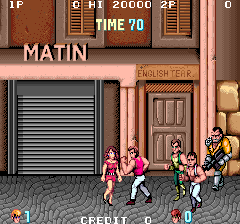
Martial
arts masters and brothers Billy and Jimmy Lee attempt
to rescue Billy's girlfriend Marian from her abductors
known as the Shadow Warriors. The game was playable
by two players simultaneously, and in addition to
using martial arts moves, the heroes could also use
items found in their environment such as knives, whips,
baseball bats, sticks of dynamite, boulders and oil
drums. Double Dragon contained a shock ending that
reveals that the leader of the Shadow Warriors, known
as Big Boss Willy, was none other than Billy's own
brother, Jimmy Lee. The final battle, if being played
cooperatively, bouts the players that were previously
in cooperation together against one another! The game
was such a HUGE hit that when it was released on home
consoles, the game box proudly stated, "You'll
never have to stand in line to play Double Dragon
again!"
Double Dragon II: The Revenge
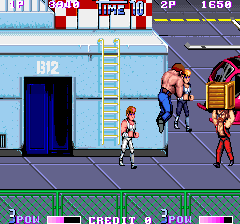
The
first Double Dragon game was such a big success that
Technos and licensing partner Romstar released the
first sequel in the growing franchise during the following
year. Part two seems to completely ignore the surprise
ending from the original, and both brothers are again
a team seeking to offer street justice to the Shadow
Warriors and their leader, the Shadow Boss. This time
their mission isn't a rescue operation, as Billy's
girlfriend Marion has been murdered and they are seeking,
as the title implies, revenge.
While
the first game had individual punch and kick buttons
for executing attacks, The Revenge alters the control
scheme and implements a 'right attack' and 'left attack'
button scenario. The Lee brothers have expanded their
martial arts moves and can now perform a devastating
new spin kick maneuver.
An
interesting fact is that the yelling sound heard when
a coin is inserted into the cabinet is a sound sample
captured from the coin-op game Kung-Fu Master.
Double Dragon III: The Rosetta Stone

Technos
released the third game of the series in 1990, with
a fundamentally different design approach both in
game play and graphic style. Billy and Jimmy Lee meet
with Hiroku, an old and mysterious fortune teller,
who challenges the brothers to travel across the globe
in search of the Rosetta Stones, and return them to
Egypt to battle with the "world's strongest enemy."
The third chapter allows for three-player simultaneous
cooperative play. The new supporting character is
none other than Sonny from Technos' first coin-op
release, Tag Team Wrestling. The control set-up from
part two was abandoned, and The Rosetta Stone returns
to the button scenario of the original Double Dragon.
Interestingly,
weapons can not be taken from defeated enemies during
game play like in the two preceding installments.
Part three contains a shop that can be visited where
weapons, special moves and even back-up support characters
with different fighting styles that can be recruited
for additional aid, must be purchased. The shopping
does not require fictional money obtained during the
game, but actual real currency. That is correct, you
must insert another coin to upgrade your status, making
The Rosetta Stone much more expensive to play.
Double Dragon
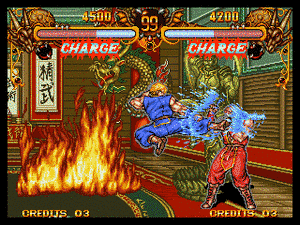
In
March of 1995, the Neo-Geo system was graced with
a new Double Dragon game with the identical name of
the original game. Again titled simply as Double Dragon,
the game is loosely based on the 1994 movie, which
was, in turn, based on the game series. It is no longer
a side scrolling beat-em up but instead is a one on
one fighting game. It draws elements from the previous
three Double Dragon arcade games and even references
the fourth console-only Super Double Dragon, which
was released on the Super Nintendo.
In
this version of the game, the two brothers are drawn
to their childhood hometown known as Bloody Town,
which is no longer a peaceful place but ruled by violence.
The story revolves around Koga Shuko and his quest
for the Double Dragon medals.
Oddly,
this game alters many of the characters from their
original conceptual design. For instance, Marian,
the weak and previously deceased damsel in distress,
is now revived as a lethal combatant. Duke, formerly
known outside of Japan as Big Boss Willy, has shaved
his beard, abandoned his machine gun, and become a
martial artist to be reckoned with!
If
you look closely during the Cheng Fu stage, you can
spot an original Double Dragon arcade cabinet situated
in the large white boat in the background.
Rage of the Dragons

While
not an officially licensed Double Dragon game, independent
game manufacturer Evoga, in cooperation with publisher
Playmore, released a sequel to the Neo-Geo Double
Dragon fighting game in September of 2002. The game
features the return of the two Lee brothers, Billy
and Jimmy; and also the return of Abobo, who has been
slightly renamed as Abubo.
If
you can't get enough Double Dragon, there are numerous
ports of the coin-op games for over a dozen home console
systems and classic computers. In addition to the
arcade games, there were also original Double Dragon
games that premiered and were only available on home
consoles:
Super Double Dragon
1992 Super Nintendo
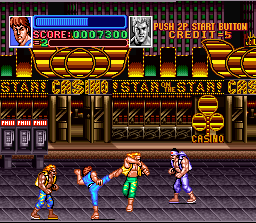
The
premiere console-specific Double Dragon title was
Super Double Dragon for the Super Nintendo. This title
featured a distinctive power meter feature that allowed
players to charge up the power meter to perform power
moves, such as the spinning jump kick, spinning back-fist,
and the cyclone spin kick.
Battletoads and Double Dragon: The Ultimate Team
1993 NES, Super Nintendo, Sega Genesis and Game Boy
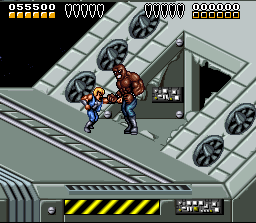
The
Battletoads arch-nemesis, the Dark Queen, has enlisted
the Shadow Boss and astonishes all do-gooders by launching
out of the moon with an enormous spaceship known as
the Colossus. Billy and Jimmy Lee join forces with
the Battletoads to battle classic enemies from both
game series.
Double Dragon V: The Shadow Falls
1994 Atari Jaguar, Sega Genesis and Super Nintendo

This
dreadful entry into the series is inspired by the
equally dreadful animated Double Dragon cartoon series.
Billy runs a martial arts dojo with his brother Jimmy
Lee, and does battle one-on-one with the enemy. This
game is a fighting game similar to the Neo-Geo arcade
Double Dragon, and not a side scrolling beat-em up.
Double
Dragon Advance
2003 GameBoy Advance
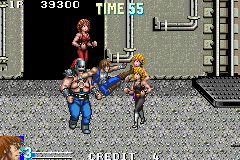
When
Technos of Japan, Corp. went bankrupt, Atlus purchased
the rights to Double Dragon. While this version is
an update of the original 1987 Double Dragon game,
Atlus added so much supplemental content, that it
became its own game. Not only has this rendition been
given a graphical overhaul, but four additional levels
have been introduced to double the amount of game
levels. This title also borrows characters, scenarios
and attack moves from Double Dragon II and Super Double
Dragon.
The
Double Dragon legacy continues in other formats, too.
The Lee brothers can be found on the silver screen,
as an action figure line, on television as a Saturday
morning cartoon, as a board game, telephone calling
cards, handheld LCD games by Tiger Electronics, a
comic book series, trading cards, an audio soundtrack,
a beach towel, as an iron-on patch, and more!
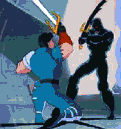
Double
Dragon
Saturday morning cartoon
